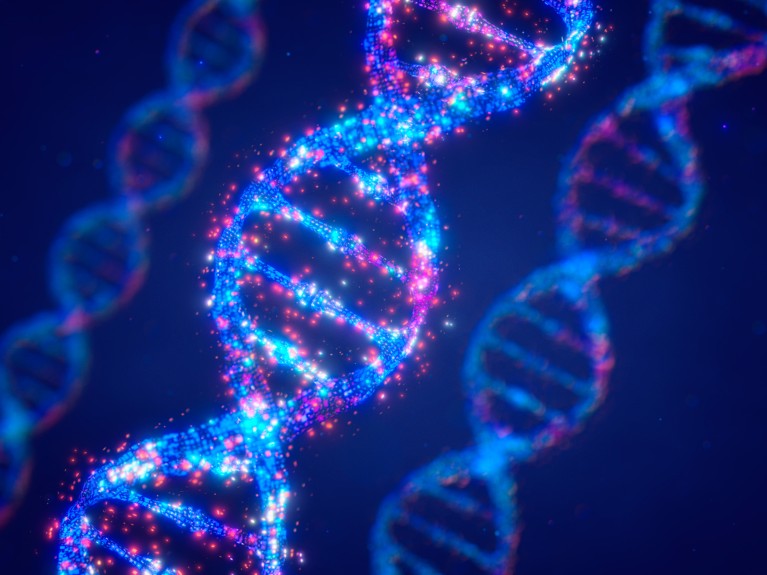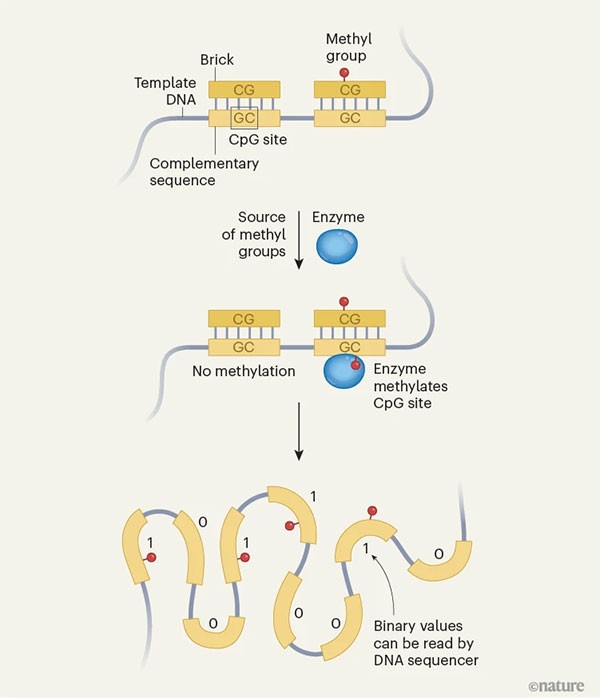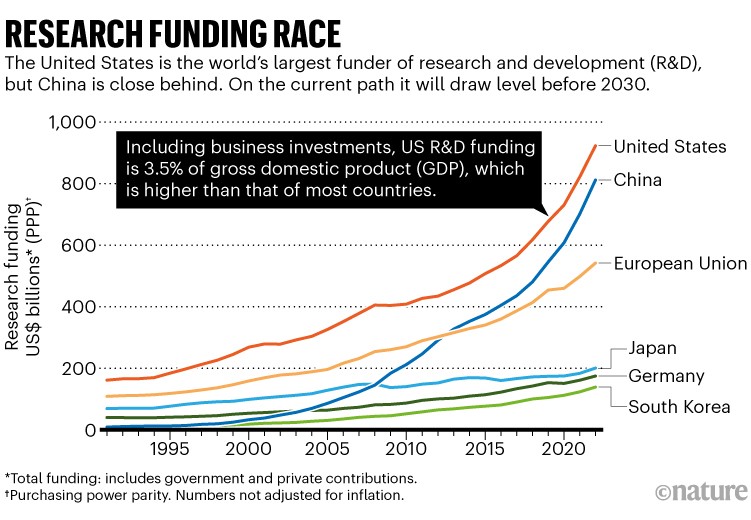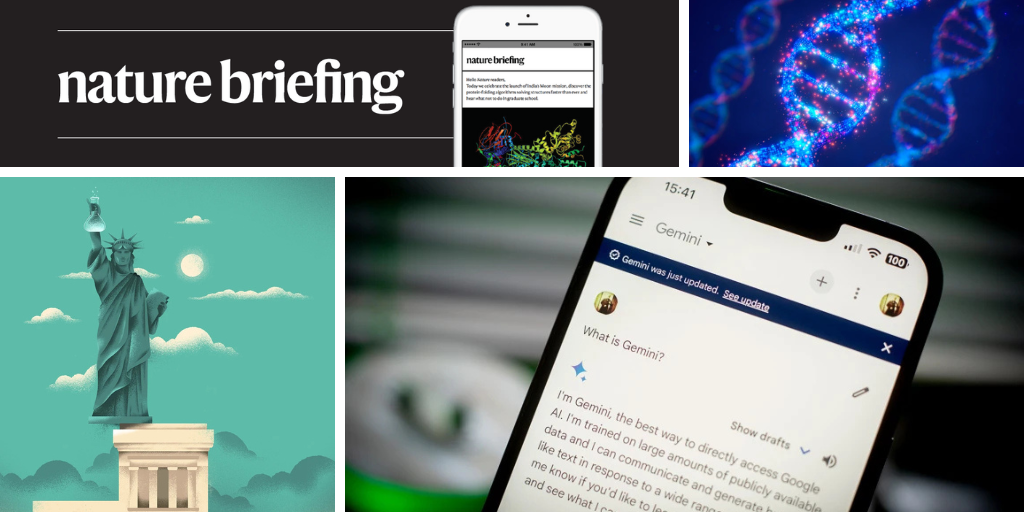Hello Nature readers, would you like to get this Briefing in your inbox free every day? Sign up here.

Chemical markers attached to pre-fabricated units of DNA can easily encode data. Credit: Nobeastsofierce/SPL
An epigenetic upgrade allows DNA to store information as a binary code — the strings of 0s and 1s used by standard computers. Researchers developed a system in which short, prefabricated DNA ‘bricks’ — with or without methyl groups — could be added to a reaction tube to form a growing DNA strand that represented a desired binary code. The encoded information could then be read using a DNA-sequencing technique that detects the methyl groups along the strand. “DNA storage has a long way to go before it could become commercially relevant,” says physicist Nicholas Guise. “But there’s a need for disruptive technology.”

Researchers prepared a template DNA molecule with a specific sequence and a set of ‘bricks’ — short DNA molecules that bind to unique complementary sequences in the template. The bricks can be methylated by attaching a methyl group (CH3) to a specific pair of nucleotides. If a brick is methylated, an enzyme will also add one to the complementary site in the template. If not, the template will remain unmethylated. The presence or absence of methyl groups on the template can be used to represent bits (binary values of 1 or 0) and can be read out using a DNA sequencer. (Nature News & Views | 7 min read, Nature paywall)
Researchers at Google DeepMind have devised a ‘watermark’, called SynthID-Text, to invisibly label text that is generated by artificial intelligence (AI) — and deployed it to millions of chatbot users. This is the first real-world demonstration of a watermark on text, which is harder to mark than images. Watermarking the output of chatbots, such as Google’s Gemini, could make it easier to identify AI-written misinformation and attempts to cheat in academia. However, researchers didn’t explore how well the watermark stands up to deliberate attempts to remove it. “In the context of AI safety, it’s unclear the extent to which this is providing protection,” says computer scientist Yves-Alexandre de Montjoye.
Our brains can comprehend some basic sentence structures quite literally in the blink of an eye. Researchers measured the brain activity of people shown a three-word sentence for 300 milliseconds, followed by another that was either the same or differed by one word. Participants made faster, more accurate judgments when the sentences contained a subject, verb and object, with brain activity detected within 130 milliseconds, which is about the length of an eye-blink. “Just like your own car is quickly identifiable in a parking lot, certain language structures are quickly identifiable and can then give rise to a rapid effect of syntax in the brain,” says linguist and study co-author Liina Pylkkanen.
Reference: Science Advances paper
Features & opinion
As the US election draws near, some scientific leaders worry that the nation’s position as the world’s leading science superpower hangs in the balance. China is hot on the heels of the US in research and development spending, and has already overtaken the country in its share of the world’s top 1% of cited papers. Heated debates about immigration and increasing political polarization might also dissuade the world’s best and brightest from pursuing careers in the United States, some experts say.

Source: OECD/MSTI
Internships aren’t just CV-fillers. They allow undergraduates and early-career scientists to apply their knowledge, develop soft skills and gain workplace experience. But getting them right isn’t always easy, and without proper support they can be stressful for students. Five researchers share what they think it takes to run a successful science internship programme. They advise keeping curiosity alive, opening channels of communication, securing institutional backing and giving students the praise they deserve.
Chemist Bruce Gibb recognizes that he’s an introvert working in a sector that increasingly caters to extraverts. The collaborative approach of ‘big science’ is a key component of the modern chemical sciences, and is increasingly favoured by funders. However, Gibb writes that large teams often find it difficult to change course, where smaller teams can be disruptive and create new opportunities. “Extraversion is a super-power,” he says. “But with great power comes great responsibility, and there is a real danger that the container-ship of big science is going to steamroll right over the dinghy of small science with barely a tremor.”
Today I’m cancelling my plans to go out drinking with an Oriental hornet (Vespa orientalis). The insects have the highest-known alcohol tolerance of any species in the animal kingdom thanks to their penchant for eating rotting fruit, which is packed with ethanol, so it would probably drink me under the table.
While I organize new plans for this evening, let me know if we can organize anything differently in this newsletter at [email protected].
Thanks for reading,
Jacob Smith, associate editor, Nature Briefing
Want more? Sign up to our other free Nature Briefing newsletters:
• Nature Briefing: Careers — insights, advice and award-winning journalism to help you optimize your working life
• Nature Briefing: Microbiology — the most abundant living entities on our planet — microorganisms — and the role they play in health, the environment and food systems
• Nature Briefing: Anthropocene — climate change, biodiversity, sustainability and geoengineering
• Nature Briefing: AI & Robotics — 100% written by humans, of course
• Nature Briefing: Cancer — a weekly newsletter written with cancer researchers in mind
• Nature Briefing: Translational Research — covers biotechnology, drug discovery and pharma


